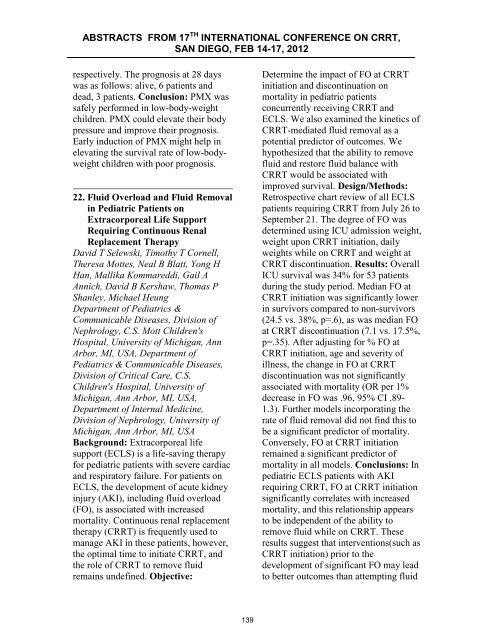ABSTRACTS from 16th International COnference on ... - CRRT Online
ABSTRACTS from 16th International COnference on ... - CRRT Online
ABSTRACTS from 16th International COnference on ... - CRRT Online
You also want an ePaper? Increase the reach of your titles
YUMPU automatically turns print PDFs into web optimized ePapers that Google loves.
<str<strong>on</strong>g>ABSTRACTS</str<strong>on</strong>g> FROM 17 TH INTERNATIONAL CONFERENCE ON <strong>CRRT</strong>,<br />
SAN DIEGO, FEB 14-17, 2012<br />
respectively. The prognosis at 28 days<br />
was as follows: alive, 6 patients and<br />
dead, 3 patients. C<strong>on</strong>clusi<strong>on</strong>: PMX was<br />
safely performed in low-body-weight<br />
children. PMX could elevate their body<br />
pressure and improve their prognosis.<br />
Early inducti<strong>on</strong> of PMX might help in<br />
elevating the survival rate of low-bodyweight<br />
children with poor prognosis.<br />
22. Fluid Overload and Fluid Removal<br />
in Pediatric Patients <strong>on</strong><br />
Extracorporeal Life Support<br />
Requiring C<strong>on</strong>tinuous Renal<br />
Replacement Therapy<br />
David T Selewski, Timothy T Cornell,<br />
Theresa Mottes, Neal B Blatt, Y<strong>on</strong>g H<br />
Han, Mallika Kommareddi, Gail A<br />
Annich, David B Kershaw, Thomas P<br />
Shanley, Michael Heung<br />
Department of Pediatrics &<br />
Communicable Diseases, Divisi<strong>on</strong> of<br />
Nephrology, C.S. Mott Children's<br />
Hospital, University of Michigan, Ann<br />
Arbor, MI, USA, Department of<br />
Pediatrics & Communicable Diseases,<br />
Divisi<strong>on</strong> of Critical Care, C.S.<br />
Children's Hospital, University of<br />
Michigan, Ann Arbor, MI, USA,<br />
Department of Internal Medicine,<br />
Divisi<strong>on</strong> of Nephrology, University of<br />
Michigan, Ann Arbor, MI, USA<br />
Background: Extracorporeal life<br />
support (ECLS) is a life-saving therapy<br />
for pediatric patients with severe cardiac<br />
and respiratory failure. For patients <strong>on</strong><br />
ECLS, the development of acute kidney<br />
injury (AKI), including fluid overload<br />
(FO), is associated with increased<br />
mortality. C<strong>on</strong>tinuous renal replacement<br />
therapy (<strong>CRRT</strong>) is frequently used to<br />
manage AKI in these patients, however,<br />
the optimal time to initiate <strong>CRRT</strong>, and<br />
the role of <strong>CRRT</strong> to remove fluid<br />
remains undefined. Objective:<br />
Determine the impact of FO at <strong>CRRT</strong><br />
initiati<strong>on</strong> and disc<strong>on</strong>tinuati<strong>on</strong> <strong>on</strong><br />
mortality in pediatric patients<br />
c<strong>on</strong>currently receiving <strong>CRRT</strong> and<br />
ECLS. We also examined the kinetics of<br />
<strong>CRRT</strong>-mediated fluid removal as a<br />
potential predictor of outcomes. We<br />
hypothesized that the ability to remove<br />
fluid and restore fluid balance with<br />
<strong>CRRT</strong> would be associated with<br />
improved survival. Design/Methods:<br />
Retrospective chart review of all ECLS<br />
patients requiring <strong>CRRT</strong> <str<strong>on</strong>g>from</str<strong>on</strong>g> July 26 to<br />
September 21. The degree of FO was<br />
determined using ICU admissi<strong>on</strong> weight,<br />
weight up<strong>on</strong> <strong>CRRT</strong> initiati<strong>on</strong>, daily<br />
weights while <strong>on</strong> <strong>CRRT</strong> and weight at<br />
<strong>CRRT</strong> disc<strong>on</strong>tinuati<strong>on</strong>. Results: Overall<br />
ICU survival was 34% for 53 patients<br />
during the study period. Median FO at<br />
<strong>CRRT</strong> initiati<strong>on</strong> was significantly lower<br />
in survivors compared to n<strong>on</strong>-survivors<br />
(24.5 vs. 38%, p=.6), as was median FO<br />
at <strong>CRRT</strong> disc<strong>on</strong>tinuati<strong>on</strong> (7.1 vs. 17.5%,<br />
p=.35). After adjusting for % FO at<br />
<strong>CRRT</strong> initiati<strong>on</strong>, age and severity of<br />
illness, the change in FO at <strong>CRRT</strong><br />
disc<strong>on</strong>tinuati<strong>on</strong> was not significantly<br />
associated with mortality (OR per 1%<br />
decrease in FO was .96, 95% CI .89-<br />
1.3). Further models incorporating the<br />
rate of fluid removal did not find this to<br />
be a significant predictor of mortality.<br />
C<strong>on</strong>versely, FO at <strong>CRRT</strong> initiati<strong>on</strong><br />
remained a significant predictor of<br />
mortality in all models. C<strong>on</strong>clusi<strong>on</strong>s: In<br />
pediatric ECLS patients with AKI<br />
requiring <strong>CRRT</strong>, FO at <strong>CRRT</strong> initiati<strong>on</strong><br />
significantly correlates with increased<br />
mortality, and this relati<strong>on</strong>ship appears<br />
to be independent of the ability to<br />
remove fluid while <strong>on</strong> <strong>CRRT</strong>. These<br />
results suggest that interventi<strong>on</strong>s(such as<br />
<strong>CRRT</strong> initiati<strong>on</strong>) prior to the<br />
development of significant FO may lead<br />
to better outcomes than attempting fluid<br />
139
















